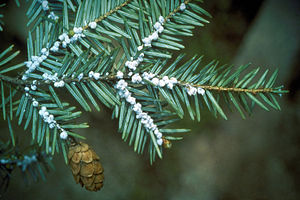The Hemlock’s Worst Enemy: The Adelgid

Adelges tsugae Annand Common Name: hemlock woolly adelgid Photographer: Connecticut Agricultural Experiment Station Archive, United States Descriptor: Adult(s) Image taken in: United States (Photo credit: Wikipedia)
An invasive and damaging insect, the hemlock wooly adelgid, native to Asia, is making its claim on a number of forests, parks, and wooded areas across the eastern United States. In the 1920’s, the hemlock wooly adelgid was accidentally introduced to the US through an import. Since then, agricultural specialists have been combating their destruction, making headway into protecting forests across the nation. This insect has been known to cause damage in a number of southern eastern states, and has also been seen as in particular areas of New England, particular Vermont and Massachusetts.
The Destruction Caused by the Hemlock Woolly Adelgid
The Hemlock tree is a very common tree found in New England, and is often found in other forests all across the world. It is an important economic and aesthetic component to varying parts of the United States, including Vermont and Massachusetts. In its adult stage, the Hemlock Woolly Adelgid often reproduces asexually, planting eggs on the underside of the leaves on hemlock trees. The woolly adelgid has also been known to attack nearby trees, deviating from their normal hemlock appetite. Larvae emerges and feeds on the sap within the shoots of the trees, leeching out the nutrients needed for proper growth. Also, the insects may emit a toxic gas, one that may cause disease to the roots and the tree itself.
Losing needles is the number one sign of woolly damage, along with the stalling of new growth. If infested, a tree often will only live for four to ten years before it withers and dies. If trees survive infestation, they still weaken and may die from secondary causes. In some areas, hemlock trees are known for providing protection from erosion and shelter for deer and other animals in the winter. The destruction of hemlock forests by the hemlock woolly adelgid, if left untreated, could be very detrimental to the overall ecological environment.
Treatments and Possible Cures
If you are seeing a problem with your hemlock trees, and you suspect hemlock woolly adelgid as the culprit, it is wise to seek professional help right away. Manual removal of the insects, washing of the trees, and cutting off infested branches may be helpful, but can be difficult if low on resources or time. Many different petrochemical pesticides are available for home owners to use to protect their trees from the woolly adelgid, of which can be obtained by a professional pesticide control company.
Due to the fact that hemlocks tend to grow near rivers, streams, and other bodies of water, the use of pesticides is limited, as the threat to wildlife is far too great a risk when releasing these sprays in the environment. The use of predatory insects are successful in controlling hemlock woolly adelgid, along with other biological control methods. These other methods include the use of insecticidal soap and the introduction of certain fungi which can be hazardous to the adelgid. Before any method is taken, however, it is always wise to contact professional services first to report the incident of this harmful insect. This can be helpful in isolating the adelgid, preventing it from spreading to nearby forests.


